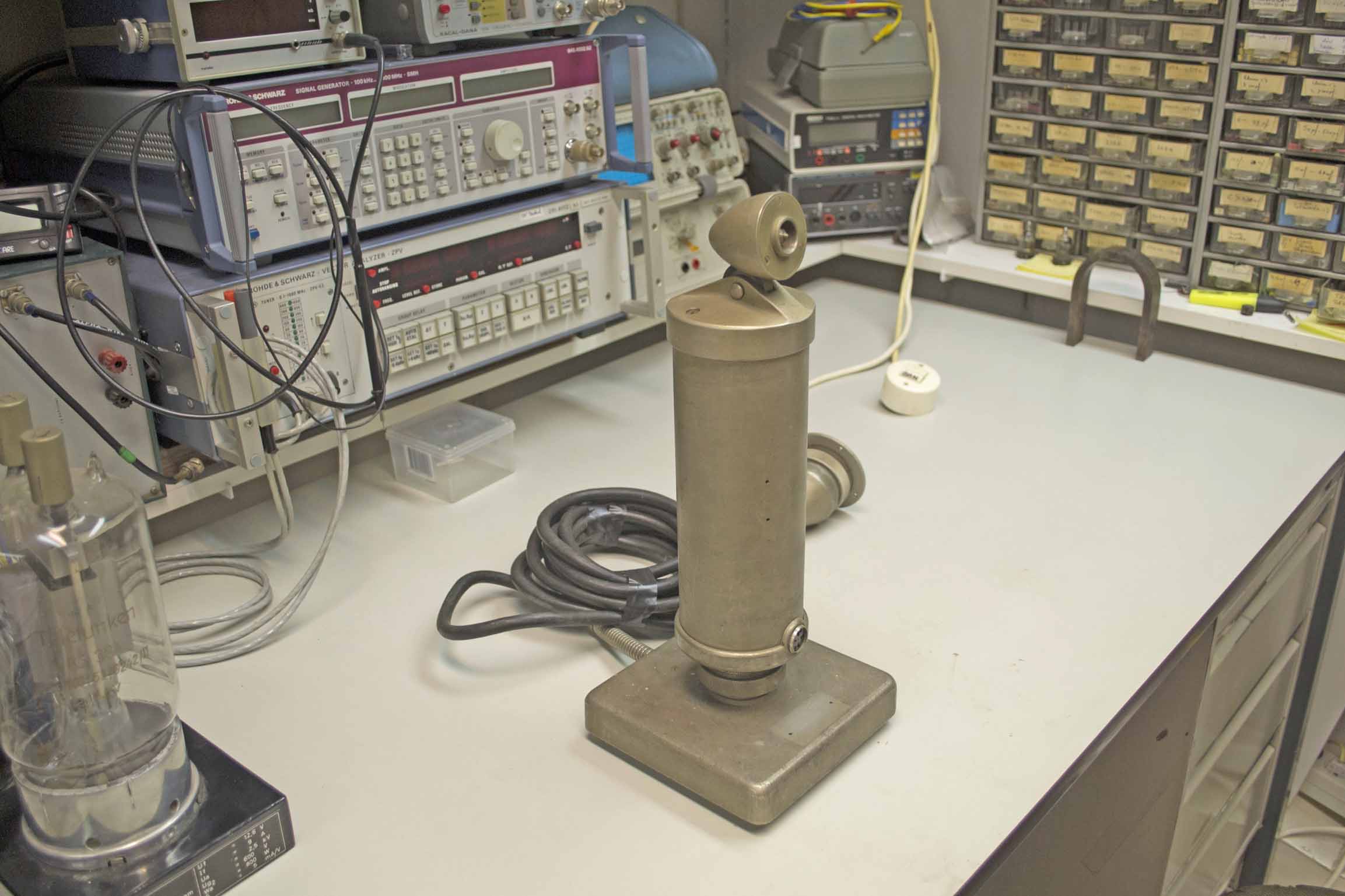
Neumann Kondensator-Flasche
Neumann-bottle-type condenser-microphone
Page initiated: 21 November 2014
Status: 21/22 November 2014
This webpage will be dedicated to some work done in our MLK lab, as to get the original M1-1a, as well as to adapt the Belgium 'modified types we got, onto my old amplifier interface.
The latter amplifier once was operated in conjunction to our AS 60 (M1K) and/or T200FK39 transmitters in the 1980s and early 1990s.
However, together with our Magnetophon T8 we got two Neumann early type microphones which were once 'modified' and the old RE084K valves being replaced by EF86 valves. For it also some supply changes had to be arranged.
Nevertheless, my amplifier built in the early 1980s, was supplying only what the genuine type necessitated (4 V dc and, of course, the regular 90 volt HT). But, the EF86 needs a higher than 4 volt filament voltage supply. Therefore the amplifier module should be modified with an additional input section. Also the audio output should be made as to fit onto the Magnetophon module type V74/b1.
As usually, modification were once being integrated, but how did these interact? This takes some time, but I finally remembered that I once also experimented with the very unique Siemens microphone SM 7a. Inverstigating our Rariteitencabinet, it proved that the SM7a was attached still with a cable having an equal connector as is having the M1-1a microphone. It therefore should be possible to do experiments with that microphone type too.
Hence, I still have to interconnect a 1 MΩ resistor with the line-input again, as to facilitate an additional dc bias for this unique microphone type SM7a. I disconnected it, because it would put 95 volt at the symmetric output cable of the M1-1a microphone. The 1 MΩ resistor in series would cause only a current against ground of maximally 95 µA. Which's value is far within any safety margin, particularly because the 95 V is only accessible when one pores a conductive pin into the microphone base-connector, touching them incidentally is thus most unlikely.

Viewing one of the 'modified' microphones

I removed first the housing and investigated whether the modification left the interconnection with outside as was done with the old microphones
This proved to be the case. Which fact makes life more easy.

However, I first considered our genuine M1-1a type microphone
We are looking at the build-in vibration-absorbing cover of the M1-1a microphone, which covers the RE084K valve. K stood for 'Klinkel frei'. I guess, that it concerns a regular RE084 production type, which was selected particularly for being less sensitive to electrode-vibrations.
What is striking, is the fact that the 'Schaumgummi' is still in a good order, after say, 75 years or beyond! By the way, this material was once invented in Germany by Pflaumer in the early years of the 1900s (he was the same one who once invented the (plastic) straw; and more matters). When you ever have encountered US products, say even from the late 1980s (but also from the 1950s and 1960s), these are almost likely heavily deteriorated, becoming annoying sticky. The reason is, that the Germans relied on 'artificial rubber', in contrast to the US and most UK products.

The top cover being removed

Metal microphone cover of the 'Belgium gift' is removed, and the accompanied modification being visible
I first considered to restore the genuine situation, but decided to leave it as it is.

Luckily the once built amplifier and its power supply still could be found in our depot
The microphone in front is the genuine M1-1a type, in the rear the 'modified' (CMV 3) type. The latter, sadly both missing their genuine type-plates; as we got the two devices from Belgium.
The M1-1a type-plate indicates that it was once sold on behalf of Telefunken, who represented the Neumann company abroad; even for decades after the war. However, CMV3 point to a genuine Neumann product once sold within the Third Reich, or in post-war days.
The amplifier and power supply was once adapted for steering the various apparatus functions involved in my amateur (HAM) station. Like - when the microphone was being activated, that the transmitter being switched-on in the A3 mode, and at the same time blocking the Köln E52a receiver by means of feeding a negative voltage onto the diversity interconnection plug. Of course, also activating the TX/RX antenna-relay.
I built in an additional selector switch; allowing operating the genuine M1-1a microphone and additionally a special 6 volt dc supply for the feeding the microphone having EF86 valves. I therefore adapted a special outside interconnection onto the genuine Neumann cable plug.

The latter genuine Neumann cable connector is clearly visible
By means of a simple switch we can at will use the genuine - or the modified microphones. Even the capsules can be interchanged.
I am very pleased to have, for simplicity, access to the old amplifier interfaces; making life easier.
To be continued in due course
By Arthur O. Bauer
Please return to, or proceed with: Magnetophon operation page